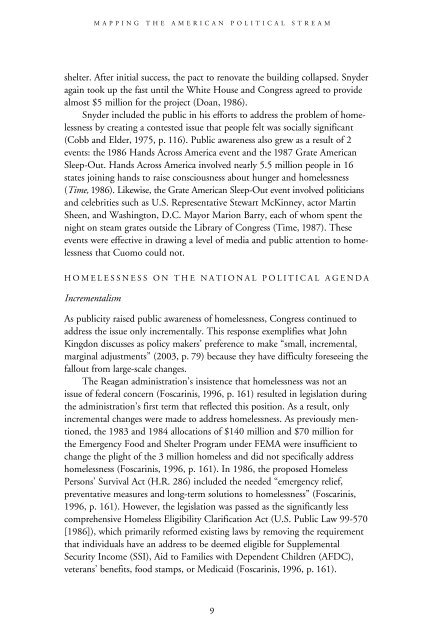2006 - School of Social Service Administration - University of Chicago
2006 - School of Social Service Administration - University of Chicago
2006 - School of Social Service Administration - University of Chicago
Create successful ePaper yourself
Turn your PDF publications into a flip-book with our unique Google optimized e-Paper software.
MAPPING THE AMERICAN POLITICAL STREAM<br />
shelter. After initial success, the pact to renovate the building collapsed. Snyder<br />
again took up the fast until the White House and Congress agreed to provide<br />
almost $5 million for the project (Doan, 1986).<br />
Snyder included the public in his efforts to address the problem <strong>of</strong> homelessness<br />
by creating a contested issue that people felt was socially significant<br />
(Cobb and Elder, 1975, p. 116). Public awareness also grew as a result <strong>of</strong> 2<br />
events: the 1986 Hands Across America event and the 1987 Grate American<br />
Sleep-Out. Hands Across America involved nearly 5.5 million people in 16<br />
states joining hands to raise consciousness about hunger and homelessness<br />
(Time, 1986). Likewise, the Grate American Sleep-Out event involved politicians<br />
and celebrities such as U.S. Representative Stewart McKinney, actor Martin<br />
Sheen, and Washington, D.C. Mayor Marion Barry, each <strong>of</strong> whom spent the<br />
night on steam grates outside the Library <strong>of</strong> Congress (Time, 1987). These<br />
events were effective in drawing a level <strong>of</strong> media and public attention to homelessness<br />
that Cuomo could not.<br />
HOMELESSNESS ON THE NATIONAL POLITICAL AGENDA<br />
Incrementalism<br />
As publicity raised public awareness <strong>of</strong> homelessness, Congress continued to<br />
address the issue only incrementally. This response exemplifies what John<br />
Kingdon discusses as policy makers’ preference to make “small, incremental,<br />
marginal adjustments” (2003, p. 79) because they have difficulty foreseeing the<br />
fallout from large-scale changes.<br />
The Reagan administration’s insistence that homelessness was not an<br />
issue <strong>of</strong> federal concern (Foscarinis, 1996, p. 161) resulted in legislation during<br />
the administration’s first term that reflected this position. As a result, only<br />
incremental changes were made to address homelessness. As previously mentioned,<br />
the 1983 and 1984 allocations <strong>of</strong> $140 million and $70 million for<br />
the Emergency Food and Shelter Program under FEMA were insufficient to<br />
change the plight <strong>of</strong> the 3 million homeless and did not specifically address<br />
homelessness (Foscarinis, 1996, p. 161). In 1986, the proposed Homeless<br />
Persons’ Survival Act (H.R. 286) included the needed “emergency relief,<br />
preventative measures and long-term solutions to homelessness” (Foscarinis,<br />
1996, p. 161). However, the legislation was passed as the significantly less<br />
comprehensive Homeless Eligibility Clarification Act (U.S. Public Law 99-570<br />
[1986]), which primarily reformed existing laws by removing the requirement<br />
that individuals have an address to be deemed eligible for Supplemental<br />
Security Income (SSI), Aid to Families with Dependent Children (AFDC),<br />
veterans’ benefits, food stamps, or Medicaid (Foscarinis, 1996, p. 161).<br />
9
















